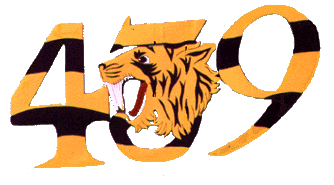|
History
of
 Squadron Squadron
  
Chapter
VII
The Advance to the Rhine
February
- March 1945
|
The messes and dispersal had been made more comfortable with the addition of new items of scrounged furniture. The airfield too was becoming more livable as an R.A.F. Works Flight had dug drainage ditches,
repaired the roads, drained and enlarged the aircraft bays. V.1s and V.2s still paid occasional, unwelcome visits.
On 13 March, a lovely, mild day, the long period of inactivity was broken by an attack by fifteen
aircraft(1) upon the rail between Dorsten and Coesfeld which yielded six good . Operations continued on a limited scale for the next ten days. Two rail interdiction expeditions on the 14th, each comprising twelve aircraft, added eleven more cuts to the month's tally. One formation led by the C.O. counted four breaks in the rails near Sudlohn, north of Borken, and the other, led by F/L Bill Davis, blew seven gaps in the Wesel Dorsten line.
Seventy degree dives were used on both attacks. Again on the 15th there were two rail shows at full squadron strength.
(1) Four Typhoons acted as fighter cover for
the eleven bombers.
|
Intentionally
left blank
|
Intentionally
left blank
|
The first formation had been briefed to bomb
"what was left" of the railway between Bocholt and Winterswijk, but when S/L Beatty reached the area he saw that the tracks had been removed, and the rails were piled on a number of flat cars near Bocholt. Two sections bombed the cars but thick haze obscured the results. Then the third section released its explosives on two tanks nearby,
destroying one and damaging the other. When the second expedition went out Beatty took one section to have another crack at the flat
cars, while the rest of the formation bombed the rails between Borken and Winterswijk. Several near misses were seen on the two targets, but no claims were made.
The next operation on 17 March developed into a blind bombing experiment. W/C Grant led the squadron to attack some unidentified enemy equipment which had been
seen stacked alongside the tracks between Wesel and Dorsten. Cloud blanketed the area and, although ground control steered the Typhoons over the target, nothing could be seen. After a vain search for a hole in the clouds the pilots had to call upon ground control to vector them into position and tell them when to release the bombs. Under such circumstances there was little satisfaction of a good job well done. The pilots preferred operations where they
could see something of the damage inflicted upon the enemy and the chaos caused in his rail communications; such results, for example, as those attained between 19 and 23 March when, in the course of eleven attacks, they blasted 39 cuts in the Reich's railways between
Borken, Rheine, Munster and Dorsten, and in addition destroyed six freight cars.
|
|
On the 19th F/L Bill Davis led the squadron on two operations which put four craters in the Borken
Ahaus line, two more in the Burgsteinfurt Rheine section, and wrote off four goods trucks. Some MET were seen but left unmolested
because of the current ban on strafing. Davis led the squadron again the next day when five cuts were made between Ahaus and Coesfeld and three more between Coesfeld and
Burgsteinfurt. On the 21st the well battered Munster Coesfeld section was bombed twice more, and six new gaps were blown in the tracks, four by a formation led by Bill Davis and two by another under W/C Grant's leadership. Two open cars loaded with gravel were also destroyed by
the bombs. Returning from one trip, the pilots watched with admiration a rocket attack upon the Coesfeld yards.
Three attacks were made on the 22nd; on the first four cuts were made by Bill Davis's pilots near Horstmar on the Coesfeld Burgsteinfurt line, and on the second Al McBride's formation counted seven craters between Coesfeld and
Dulmen. Medium and heavy bombers had been battering Coesfeld into rubble these days, stirring up so much smoke that much of the area was obscured. When F/L Davis took the third expedition out on the evening of the 22nd the wind had carried the
"bombing haze" to the north and the pilots were unable to see their target.
  
Copyright
©1998-2016 Michael T. Melnick. All rights reserved
the
unofficial homepage of  Tiger
Squadron Tiger
Squadron
.
.
|
|